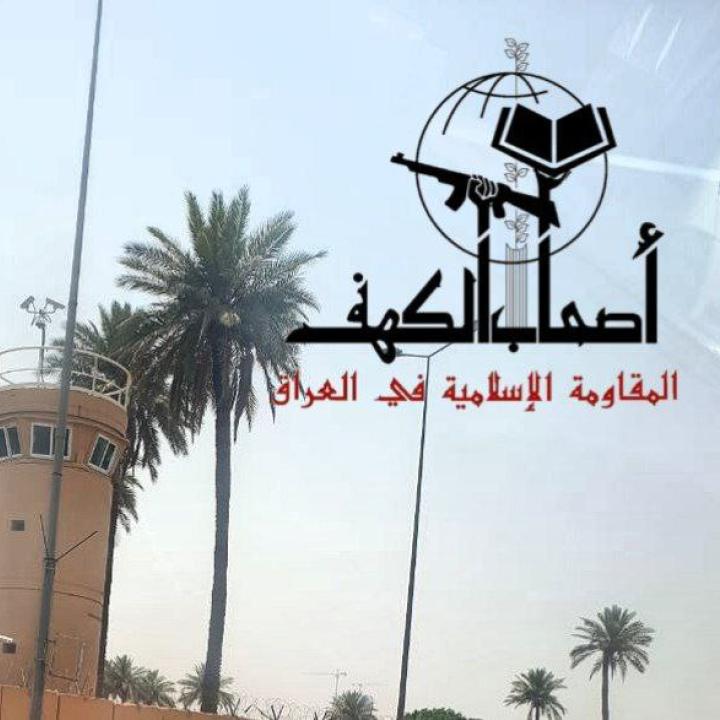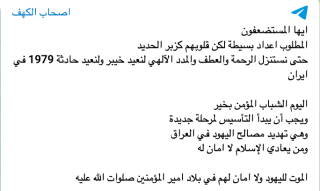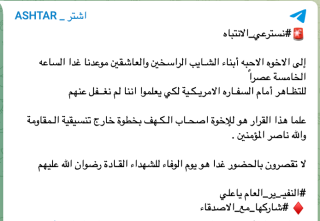
Ashab al-Kahf's "Iraqi Basij" and the Threat Against the U.S. Embassy in Baghdad

The militia entity has created a new Persian-named protest group and called on mobs to storm the embassy compound.
On July 14, the facade group Ashab al-Kahf (AK) organized a protest against the U.S. embassy in Baghdad, an event that stood out for three reasons:
- It was the first such protest under the government of Prime Minister Mohammad Shia al-Sudani.
- It was the first time AK had organized a protest.
- AK used the occasion to unveil a new "popular" movement called al-Tabea al-Shabiya fil Iraq (the Popular Mobilization in Iraq, aka the Iraqi Basij).
AK sister channels began advertising the event on social media earlier this month using the hashtag "حاصروا السفارة" (besiege the embassy). On the morning of July 14, AK's main social media channel posted a message asking muqawama (resistance) supporters to storm the embassy. The message read: “What is required is small numbers [of protesters] whose hearts are like iron to be bestowed with mercy, kindness, and divine support to repeat the Khaybar [event] and bring back the 1979 incident in Iran” (Figure 1).
Khaybar refers to the Battle of Khaybar in 629, when a Muslim army besieged and eventually stormed a fort belonging to a group of Medinese Jews. The "1979 incident" refers to the storming of the U.S. embassy in Iran, where staff were taken hostage for 444 days. AK’s message continued: “[We] must usher in a new era in which the Jews’ interests in Iraq are under threat and he who is an enemy of Islam is not safe.”
AK had not mobilized protests prior to this march; instead, it had focused on claiming roadside attacks against logistical convoys and occasional rocket attacks. Now, however, the group has seemingly decided to engage in street actions organized through its new "Iraqi Basij" brand (see our profile of this group here). Basij is a Persian term that literally means "mobilization" and also refers to the various Iranian paramilitary groups that operate under the Islamic Revolutionary Guard Corps (IRGC).
Going forward, the Iraqi Basij might play a role previously filled by vigilante groups such as Raba Allah, which were responsible for many protests and illegal activities during Prime Minister Mustafa al-Kadhimi's tenure (e.g., burning the offices of television channels and political parties). These groups were formed and led by the Iran-backed militia Kataib Hezbollah (KH), which now seems less interested in such activities. Yet the Iran-backed militia Harakat Hezbollah al-Nujaba has apparently stepped into this space via its facade group AK and the new Iraqi Basij.
In the end, AK failed to mobilize a large crowd for the protest, likely reflecting internal divisions among top militias. Although AK sister accounts announced that free transportation and food would be provided for protesters who travel from other cities, some muqawama social media channels made clear that their main political coalition—the Tansiqiya, or Coordination Framework—was not behind the event (Figure 2).
The lack of consensus also meant that the expansive muqawama media infrastructure refrained from promoting the march. That includes Sabereen News, the muqawama social media channel most responsible for mobilizing such protests during Kadhimi's tenure.
For the most part, major militias were eager to be seen as supporting the cause of this protest without vocally promoting the march itself. Some members of parliament affiliated with the muqawama—Hassan Salim of Asaib Ahl al-Haq’s (AAH) al-Sadiqoun bloc and Saud al-Saedi of KH’s Hoquq bloc—briefly attended the protest. This was apparently KH and AAH's attempt to avoid criticism from the core muqawama support base for their failure to push the anti-American event, suggesting that if similar protests gain momentum in the future, major militias could be drawn into supporting them more openly online and in the streets.






